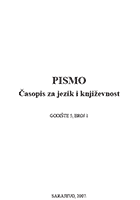Leksičke promjene – pokazatelj društvenih promjena
Lexical changes – the indicator of social changes
Author(s): Amela ŠehovićSubject(s): Language and Literature Studies
Published by: Bosansko filološko društvo
Keywords: leksika; leksema; kontekst; arhaizmi historizmi; formalni arhaizmi; neologizmi; žargonizmi; vulgarizmi; tabu-riječi
Summary/Abstract: Social development is most directly seen on the lexical level. Many lexemes from dramas are today historical archaisms: obikuša, muhtar, ceribaša, kolhoz, drug i drugarica as etiquettes for communication, formal archaisms: jenđija, and phrases such as na radnoj obavezi are as well a part of archaisms in dramas, although it is more common to consider only lexemes as archaisms. They all have chronolectic features. Dramas confirm the revitalization of formal archaisms: gazija, mudžahedin, šehid, and for that reason many linguists show (a just) skepticism towards the term archaism. The popularization of religion and the manifestation of religious feelings in the last ten years caused a frequent usage of lexemes that had been previously considered to be stylistically marked, while today they are almost neutral according to this criterion (such is the lexeme Džehennem). The phenomenon of globalization as well influences the invasion of foreign words in our language, and these words don’t adapt to our language on any level, e. g. refugees, luftbalon. The situation is the same as with archaisms, neologisms can be both lexemes and phrases: plavi šljemovi. Besides, the speech of female characters is as well an indicator of social changes: in modern dramas women use vulgarisms and taboos, and that is not a traditional view. These social changes can be shown through jargons as well, especially the ones influenced by, or even directly taken from English: fantastično, cool. All these examples point to the conclusion that language is connected to the society in all its periods; it is a part of the society, and it must not be analized separately in sociolinguistic research.
Journal: Pismo - Časopis za jezik i književnost
- Issue Year: 2007
- Issue No: 05
- Page Range: 48-58
- Page Count: 11
- Language: Bosnian

